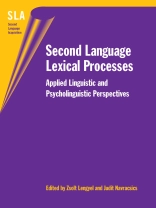The book contains studies on second language lexical processes based on empirical findings by authors mostly from Central Europe. The reader may have access to how lexical items are stored in the memory and also to how second language lexicons work in speech processing. Questions of the two lexicons’ integration or separation, the fashion of bilingual word storage, vocabulary acquisition and assessment, word retrieval from the memory and lexical access are the focus of the studies. The authors of the studies refer to analyses of different psycholinguistic experiments (e.g. a word association test, speech perception tests, a Cloze-test). Assessment of written work of second language learners both at secondary school and university levels is also provided. Second language lexical acquisition processes are described and the influences of different types of languages on each other are shown. The second languages involved are mainly internationally less widely investigated and published languages of Finno-Ugric (i.e. Hungarian) and Indo-European (e.g. Croatian, Polish, Russian, etc.) origin next to the more frequently studied English and German. The studies included in our volume focus on lexical acquisition and processing and also make reference to pedagogical questions. They include investigations of lexical perception, production, acquisitional processes and vocabulary assessment. The novelty of the book is that the studies make reference to Hungarian and a number of Slavic languages. They provide the reader with new perspectives on second language lexical acquisition processes when the source language and the target language are distinct from a typological point of view, the lexicon in processing terms. The book is intended for the use of undergraduate and graduate students of second language studies, psycholinguistics and/or bilingualism researchers, teachers and academics whose interests include a second language acquisition component.
Cuprins
PREFACE – Zsolt Lengyel and Judit Navracsics
PART 1: THE NATURE OF THE L2 MENTAL LEXICON
1. How Integrated is the Integrated Mental Lexicon? – David Singleton
2. Word Classes and the Bilingual Mental Lexicon – Judit Navracsics
PART 2: L2 LEXICAL PERCEPTION AND PRODUCTION
3. Speech Perception Processing in First and Second Language in Bilinguals and L2 Learners – Mária Gósy
4. A Comparative Study of Mother-tongue and Foreign Language Speech Perception, Lexical Access and Speech Comprehension Processes – Orsolya Simon
5. Slip of the Doctor’s Eye? Recognizing English Contact Induced Features in Hungarian Medical Texts – Csilla Keresztes
PART 3: THE LEXICON IN L2 WRITING
6. Vocabulary Assessment in Writing: Lexical Statistics – Ewa Witalisz
7. The Use of High- and Low- Frequency Verbs in English Native and Non-native Student Writing – Katalin Doró
PART 4: THE LEXICON IN SECOND LANGUAGE ACQUISITION
8. Selection of Grammatical Morphemes in Early Bilingual Development – Zsuzsanna Gergely
9. The Importance of Language Specific Features for Vocabulary Acquisition: An Example of Croatian – Lidija Cvikic
10. Analyzing L2 Lexical Processes via C test – Zsolt Lengyel, Judit Navracsics and Anikó Szilágyi
Despre autor
Judit Navracsics is Professor of Linguistics at the University of Pannonia, Veszprém, Hungary. Her research interests are bi- and multilingual development in early childhood, the bilingual mental lexicon and bilingual processing.












